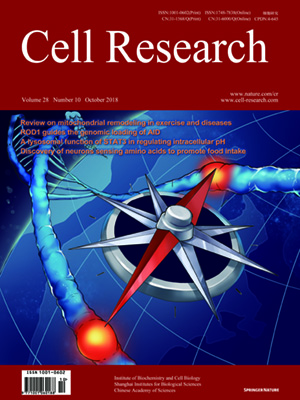
Volume 28, No 10, Oct 2018
ISSN: 1001-0602
EISSN: 1748-7838 2018
impact factor 17.848*
(Clarivate Analytics, 2019)
Volume 28 Issue 10, October 2018: 996-1012 | Open Access
ORIGINAL ARTICLES
STAT3 associates with vacuolar H+-ATPase and regulates cytosolic and lysosomal pH
Bin Liu 1, Johan Palmfeldt 2, Lin Lin 3, Alexandria Colaço 1, Knut K. B. Clemmensen 1, Jinrong Huang 4,5,6, Fengping Xu 4,5,6, Xin Liu 4,6, Kenji Maeda 1, Yonglun Luo 3,4,6 and Marja Jäättelä 1,7
1Cell Death and Metabolism, Center for Autophagy, Recycling and Disease (CARD), Danish Cancer Society Research Center (DCRC), DK-2100 Copenhagen, Denmark; 2Research Unit for Molecular Medicine, Department of Clinical Medicine, Aarhus University Hospital and Faculty of Health, Aarhus University, DK-8200 Aarhus, Denmark; 3Department of Biomedicine, Aarhus University, DK-8000 Aarhus, Denmark; 4BGI-Shenzhen, Shenzhen, Guangdong 518083, China; 5Department of Biology, University of Copenhagen, DK-2200 Copenhagen, Denmark; 6BGI-Qingdao, Qingdao, Shandong 266555, China and 7Department of Cellular and Molecular Medicine, Faculty of Health Sciences, University of Copenhagen, DK-2200 Copenhagen, Denmark
Correspondence: Correspondence: Bin Liu (liu@cancer.dk) or Marja Jäättelä (mj@cancer.dk)
Dysregulated intracellular pH is emerging as a hallmark of cancer. In spite of their acidic environment and increased acid production, cancer cells maintain alkaline intracellular pH that promotes cancer progression by inhibiting apoptosis and increasing glycolysis, cell growth, migration, and invasion. Here we identify signal transducer and activator of transcription-3 (STAT3) as a key factor in the preservation of alkaline cytosol. STAT3 associates with the vacuolar H+-ATPase in a coiled-coil domain-dependent manner and increases its activity in living cells and in vitro. Accordingly, STAT3 depletion disrupts intracellular proton equilibrium by decreasing cytosolic pH and increasing lysosomal pH, respectively. This dysregulation can be reverted by reconstitution with wild-type STAT3 or STAT3 mutants unable to activate target genes (Tyr705Phe and DNA-binding mutant) or to regulate mitochondrial respiration (Ser727Ala). Upon cytosolic acidification, STAT3 is transcriptionally inactivated and further recruited to lysosomal membranes to reestablish intracellular proton equilibrium. These data reveal STAT3 as a regulator of intracellular pH and, vice versa, intracellular pH as a regulator of STAT3 localization and activity.
https://doi.org/10.1038/s41422-018-0080-0
FULL TEXT | PDF
Browse 1756


